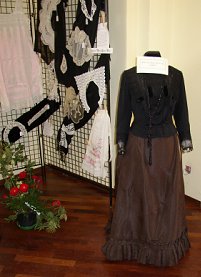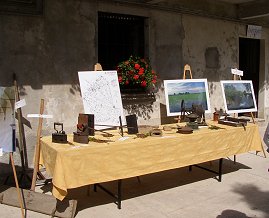
HISTORY, ENVIROMNENT AND EXIBITIONS
|
HISTORY
Most of the history of Treville was written down by the recently-deceased Prof. Giuseppe Spina in his book "Treville -- Vicissitudes of a Small Village of the Basso Monferrato" (Comune of Treville ed., 1994). Part of the historical data included in this now-rare book were used by Lorena Balbo in a brochure produced some years ago by the Comune of Treville.
History (by Lorena Balbo)
We don't have information about the origin of the name Treville: the most ancient acts speak about "TRIVILLA", which allows us to guess that, during the XI-XII centuries, three settlements existed on the site.
For a long time, the historical events of this region have only marginally touched on the life of this village characterized by a rural economy and for this reason it's only possible hypothesize about Treville during the town's earliest epoch.
The first document is a 1202 decree in which the Marquis Bonifacio Ist Aleramo entrusted the fiefdom to the noble Anselmo Musso of Paciliano. The local Treville Statutes date back to 1303 and are among the most ancient in the Monferrato.
During the following centuries the fiefdom passed to different squires. In 1403 Teodoro Paleologo the First entrusted it to George Areccio and in 1435 the dominion was attributed to Giacomino of Biandrate. During the dominance of the Monferrato by the Gonzaga of Mantova it was sold to Giulio Strozzi (1590) and to Gerolamo Amorotto de Andreasi (1602). In 1699, Giacomo Bartolomeo Gozani acquired it. His family of businessmen became wealthy in Casale by coining money and owned many fiefdoms in the Monferrato. In local lore, the Gozani are best remembered for commissioning Palazzo Treville, the best Baroque building in Baroque in Casale Monferrato, and long the pride of the family.
In 1713, Treville passed to the Savoia dynasty, which upon unification, became the royal family of Italy.

Riso e Rose 2003 (Rice and Roses)
1850 wedding dress
____________________________________
ENVIRONMENT (by Lorena Balbo)
Sweet hills, those to the southwest, slowly untie themselves from Casale Monferrato toward Asti.
A harmonious flow of valleys and ridges on which the grapevine, undisputed queen of these territories, climbs, creating perfect geometries with cultivated and uncultivated fields; These are strips of earth of which the nature retakes possession and returns to us the authentic image of this region.
Here, 12 km from Casale (the ancient capital of the Monferrato) off the beaten path, we discover TREVILLE, small village of 287 inhabitants, at an altitude of 310 m. Thanks to its fortunate southern exposure, it enjoys of a particularly favorable microclimate. Excluding summer, the average temperature is 1-2 degrees higher than in neighboring communes, allowing, among other things, significant vegetable cultivations (artichokes and capers are traditionally considered a specialty; this DOC wine area is one of the highest altitudes in the Province of Alessandria).

Rice and Roses 2003 - country art
EXHIBITIONS
RISO E ROSE (Rice and Roses; May): exhibitions of rustic objects, folk wisdom and contemporary art.
ART EXIBITIONS (spring
to summer): contemporary artists show their works in the St. Giacomo church.
TREVILLE IN FESTA
(July), country feast with gastronomic and dance days;
ELDERLY DAYS (August), Sunday lunch on the square;
ORGAN MUSIC CONCERT (first Sunday of September), in the Saint Ambrogio Parish, in memory of the Master Angelo Surbone, who donated a big pipe organ to the parish church.

Manuela Santagata
in Saint Giacomo church, August 2003
(Photo by GP Morano)
|